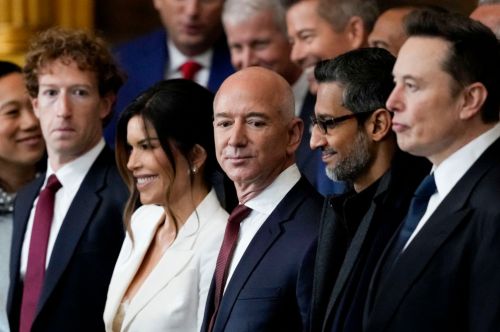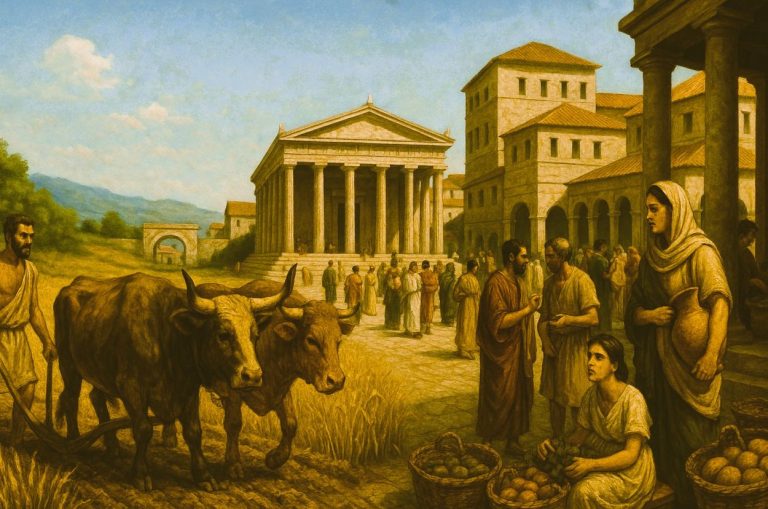

Feudalism did not vanish with the drawbridge and the sword. It evolved, adapted, and disguised itself in the language of progress.

By Matthew A. McIntosh
Public Historian
Brewminate
Introduction: The Myth of Modern Freedom
We like to imagine we live in a society transformed, liberated from the rigid class hierarchies of medieval times. Democracy replaces divine right, markets replace serfdom, and mobility replaces birthright. Yet beneath these conceits lies a harsher truth: feudalism didn’t die; it evolved. What we now call “capitalism” is simply the old system in a new skin, and its new lords are fewer, fiercer, and better hidden.
Today, the richest 1 percent of Americans claim roughly 20 percent of all income. That level of extraction from the many to sustain the few sounds more feudal than free. But the story deepens. Within that 1 percent lies an even more exclusive elite, the 0.01 percent, households whose fortunes often exceed nine-figure net worths, whose returns on capital dwarf labor earnings, and whose political influence can shape legislation, regulation, and even public opinion.
So yes, the castle walls may have shifted from stone to glass towers and boardrooms. But the moat remains, the drawbridge is still controlled, and the peasantry (the millions of working people, contract giggers, and indebted households) still bear the brunt of the burden.
This article will show how the elite class today function as feudal lords: how they concentrate wealth, capture policy, define culture, and extract from the many to preserve the few. And it will ask: what must change if the serfs are ever to stop paying for someone else’s throne?
The New Lords: Concentrated Wealth and Power
If the medieval nobility wielded their dominance through land, today’s lords command it through capital. Ownership (not of soil but of stocks, data, and debt) defines power in the 21st century. The tools have changed, but the structure has not: the few control the means by which the many live.
According to the Chicago Booth Review’s analysis, the top 0.01 percent of Americans now control nearly 10 percent of the nation’s total wealth, a share that has tripled since 1980. These are not simply the CEOs and hedge fund magnates who dominate the headlines. They are dynastic investors, private equity founders, and heirs to transnational fortunes whose capital quietly multiplies across borders and generations.
Their modern estates are not manors, but multinational corporations: sprawling conglomerates where influence radiates downward through executives, consultants, and contractors, the new vassals of the global order. Each layer extracts value from those beneath, while channeling wealth upward through dividends, buybacks, and tax havens.
Meanwhile, the supposed guardians of public interest, legislators and regulators, increasingly resemble stewards of these estates rather than overseers of justice. Corporate lobbying reached $4.1 billion in 2023, an all-time record, ensuring that the tax codes, subsidies, and labor laws remain firmly tilted toward the ultra-wealthy. The result is a political economy calibrated to serve the rentier class, one that privatizes gains while socializing losses.
The irony, of course, is that this concentration of wealth mirrors the very feudalism capitalism once promised to replace. Where medieval peasants paid rents in crops and labor, today’s workers surrender time and productivity (measured, optimized, and monetized) for the bare privilege of survival. As Friedrich-Ebert-Stiftung researchers noted two decades ago, global neoliberalism has fostered a “new hierarchy of dependency,” where states and citizens alike orbit the gravitational pull of concentrated private capital.
This is not free enterprise; it is financial vassalage. And while its rituals are cloaked in corporate jargon and quarterly reports, the end remains the same: wealth flows upward, power calcifies, and the myth of meritocracy becomes the moral varnish for inequality.
Corporate Fiefdoms and Wage Serfs
If the modern aristocracy rules through capital, their dominion is enforced through labor dependency. In the Middle Ages, serfs worked the land under oath to their lords; in the 21st century, workers sell their time and attention to corporations whose power extends as deeply into private life as feudal obligations once did. The terms are different, but the contract is the same: servitude disguised as opportunity.
Real wages for most Americans have stagnated for decades, while productivity and profits have soared. Since 1979, worker productivity has increased by nearly 65 percent, but hourly compensation has risen only 18 percent, meaning the vast majority of gains have been siphoned upward. The very workers generating wealth for the system are trapped within it, bound by debt, health costs, and the rising price of basic survival.
The gig economy intensifies this dependency, trading stability for “flexibility.” It’s a clever linguistic rebranding, serfdom as self-employment. Millions now operate as subcontractors, bearing their own risks, taxes, and expenses while the corporations that employ them evade responsibility. The model is pure feudal logic: decentralize duty, centralize profit.
Corporate welfare further distorts the landscape. In the United States, the federal government spends tens of billions annually on subsidies, bailouts, and tax breaks that benefit the wealthiest sectors, oil, banking, and technology among them. These policies are justified as incentives for innovation but function, in reality, as a system of tribute: public funds flowing upward to preserve private empires. The Friedrich-Ebert-Stiftung’s research on “state feudalism” captures this dynamic precisely, the fusion of state power and private privilege that defines the modern political economy.
Beneath it all, the ideology of “the free market” works as the church once did, sanctifying the system’s inequalities through moral language. Success is grace; failure, sin. The billionaire is celebrated as visionary; the worker who cannot escape debt is told to pray harder to the gods of hustle and entrepreneurship. And just as peasants once feared excommunication, today’s wage earners fear unemployment, the social death that comes when one falls out of the corporate order. The feudal chain has merely been digitized, not destroyed.
The Political Order: The Ruling Class and Policy Capture
In every era, power seeks legitimacy. Medieval monarchs invoked divine right; modern elites invoke democracy. But the outcomes look strikingly similar: policy shaped by the privileged, systems designed to perpetuate their privilege, and a populace told their suffering is the price of stability.
The United States likes to imagine itself as a government “of the people.” Yet the evidence tells a different story. Political scientists Martin Gilens and Benjamin Page found in their landmark Princeton study that the policy preferences of average citizens have “a near-zero level of statistical significance” on legislation outcomes, while economic elites and organized business interests exert a dominant influence. In other words, democracy functions largely as a spectacle through which the ruling class governs by consent, not from the people, but over them.
Corporate lobbying cements this rule. In 2023 alone, corporations spent over $4.1 billion on lobbying, a record level that effectively ensures their interests outweigh public will. Political campaigns rely heavily on private donations, meaning candidates rise or fall not on popular appeal, but on their compatibility with the donor class.
This dynamic reached its most visible form during the Trump years. The Monthly Review describes the Trump regime as an “open expression of class rule,” where tax cuts for the wealthy, deregulation, and judicial appointments served to entrench elite power while cloaking it in nationalist populism. What appeared as rebellion against the establishment was, in practice, its rebranding, the same oligarchy under a different flag.
Policy capture extends far beyond Washington. Global financial institutions, think tanks, and tech conglomerates form a transnational network of influence that dictates not only domestic policy but international economic order. Trade agreements, debt structures, and austerity measures ensure that the hierarchy of wealth remains unchallenged, even across borders.
And like medieval monarchs convening their courts, today’s rulers meet in exclusive summits (Davos, Bilderberg, G7) where global agendas are discussed in private while billions of lives are affected in public. Their language may be technocratic, but their aim is ancient: maintain control through the management of dependency.
The ruling class no longer needs to crush uprisings with swords or decree; it governs through legislation, media narratives, and market discipline. Dissent is defanged by bureaucracy, co-opted by branding, or buried under debt. The crown has simply become invisible.
Cultural Hegemony: The Ideology of the “American Dream”
No empire endures by force alone. To last, it must convince its subjects that the order of things is natural, moral, and inescapable. In medieval Europe, religion played that role, sanctifying the hierarchy as God’s will. In modern America, the myth of the American Dream serves the same function. It transforms economic subjugation into personal failure and turns inequality into a moral narrative of merit and grit.
The ruling class does not merely dominate through wealth and policy; it rules through imagination. As Jacobin observed in its essay on the “rot of the American ruling class,” capitalism’s greatest success is not in production, but in persuasion, in selling the illusion that freedom can coexist with servitude.
Popular culture, mass media, and political rhetoric all reinforce this belief. From childhood, Americans are taught that anyone can succeed with enough hard work, a faith that persists even as upward mobility collapses and social safety nets erode. Billionaires are framed not as inheritors of privilege but as innovators and visionaries, moralized as symbols of hope rather than evidence of structural failure.
This ideological alchemy transforms exploitation into aspiration. A warehouse worker watching Jeff Bezos’s space launch is told not to question the inequality that made it possible, but to admire it. The system’s very excesses become part of its mythology. As long as people believe that wealth is earned rather than extracted, the hierarchy holds.
The media’s complicity is not always conspiratorial, often it’s structural. News outlets depend on advertising revenue, entertainment industries rely on corporate sponsorship, and the algorithms of social media are optimized for distraction rather than dissent. The result is a culture that rewards conformity and ridicules critique, where outrage is monetized but rebellion is neutered.
And so, like medieval peasants who believed obedience would earn divine favor, modern workers internalize the gospel of meritocracy. Failure becomes personal; poverty becomes shame. Yet in truth, both are systemic, predictable outcomes of a design meant to preserve the privileges of the few.
Antonio Gramsci called it cultural hegemony: when the ruling class so thoroughly shapes a society’s norms and values that domination becomes invisible, indistinguishable from reality itself. In that sense, America may be the most successful feudal society ever built, one whose peasants proudly defend their lords, certain that one day, by luck or faith, they’ll join them.
The Peasantry Pushes Back
Every age of feudal domination eventually meets its reckoning. No hierarchy remains eternal once those beneath it begin to see its scaffolding clearly. The old order depended on obedience; the new one depends on distraction. But even under the blinding light of constant media noise, cracks are forming.
Across the United States, and increasingly across the world, workers, renters, and citizens are beginning to rediscover the language of collective struggle. Strikes once considered relics of the industrial age have returned with force. In 2023, U.S. workers launched more than 450 major work stoppages, affecting millions, from Hollywood writers to autoworkers, from nurses to baristas. Each fight was more than a demand for higher wages; it was a declaration that the economy should serve the people who sustain it.
Grassroots movements are reclaiming terrain long ceded to the elite. Union membership, though still far below mid-20th-century levels, has seen a cultural resurgence. Younger generations, burdened by debt and disillusioned with corporate ethics, view organizing not as radicalism but as self-defense. At the same time, campaigns for wealth taxes, universal healthcare, and public ownership of essential services are reframing the moral terms of the debate: inequality is not a symptom; it is the system.
This pushback is not confined to picket lines. Digital activism, though easily commodified, has also become a weapon of visibility. From online labor forums to viral unionization drives, the very tools once used for surveillance and marketing are being repurposed for solidarity. It’s messy, inconsistent, and often infiltrated by the same capital interests it resists, but it’s real.
Still, the ruling class has learned from history. Where medieval lords crushed revolts with force, modern elites smother them with bureaucracy. Legal loopholes, anti-union statutes, and public-relations campaigns frame collective action as chaos, and reform as extremism. The system adapts, but so do the people.
The stirrings of resistance signal something deeper than discontent: an awakening to the fact that capitalism’s moral legitimacy has begun to decay. When the stories that justify inequality stop working, the order that depends on them begins to wobble. The question is not whether people will rebel; they already are. The question is whether that rebellion will find coherence before it’s co-opted, commodified, or crushed.
Conclusion: A Cycle Unbroken
Feudalism did not vanish with the drawbridge and the sword. It evolved, adapted, and disguised itself in the language of progress. Its castles became corporations, its banners became brands, and its lords became shareholders. What changed was not the structure of power, but the sophistication of its disguise.
In truth, the long arc of human history bends less toward justice than repetition. Every new economic order inherits the skeleton of the one it replaced. The same hierarchy (ruler and ruled, creditor and debtor, owner and laborer) persists under different names and flags. The feudal oath has become the employment contract; the tithe, the tax cut for the rich; the church’s moral code, the market’s invisible hand.
The American experiment was meant to break that cycle, to distribute power through democracy, dignity, and opportunity. But as the top 1 percent continue to seize nearly one-fifth of the nation’s income, and the 0.01 percent accumulate wealth beyond imagination, it’s clear that the revolution never finished. It merely paused while the powerful rebranded.
Still, the story is not over. Every social order contains within it the seeds of its undoing. The medieval serfs who once believed their bondage eternal eventually rose, and so too can those bound by debt and wages today. The first step is seeing through the illusion, recognizing that inequality is not a law of nature but a deliberate design.
The ruling class may control the wealth, the media, and the machinery of policy, but they cannot forever control the narrative. The myths are cracking. And when myths collapse, empires follow.
History teaches that feudal lords fall not when their castles are stormed, but when their legitimacy erodes. That moment always begins the same way, when ordinary people, in all their quiet, collective courage, stop believing the lie that they were ever meant to kneel.
Originally published by Brewminate, 10.06.2025, under the terms of a Creative Commons Attribution-NonCommercial-NoDerivatives 4.0 International license.


